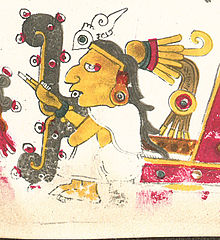Tēcciztēcatl
In Aztec mythology, Tecciztecatl (Classical Nahuatl: Tēcciztēcatl [teːk.sis.ˈteː.kat͡ɬ], "person from Tēcciztlān," a place name meaning "Place of the Conch," from tēcciztli or "conch"; also Tecuciztecatl, Teucciztecatl, from the variant form tēucciztli) was a lunar deity, representing the Man in the Moon.
[1] The Aztecs believed that they were living in a universe dominated by generations of sun gods, the current one, known as Tonatiuh, was the fifth.
The fourth was wiped out by a flood when people turned into fish and spread through the ocean.
Tecciztecatl gained his courage and followed Nanahuatzin, thus forming two suns in the sky.
[1] In some depictions, Tecciztecatl carried a large, white seashell on his back, tēucciztli in Nahuatl, representing the Moon itself; in others he had butterfly wings.
